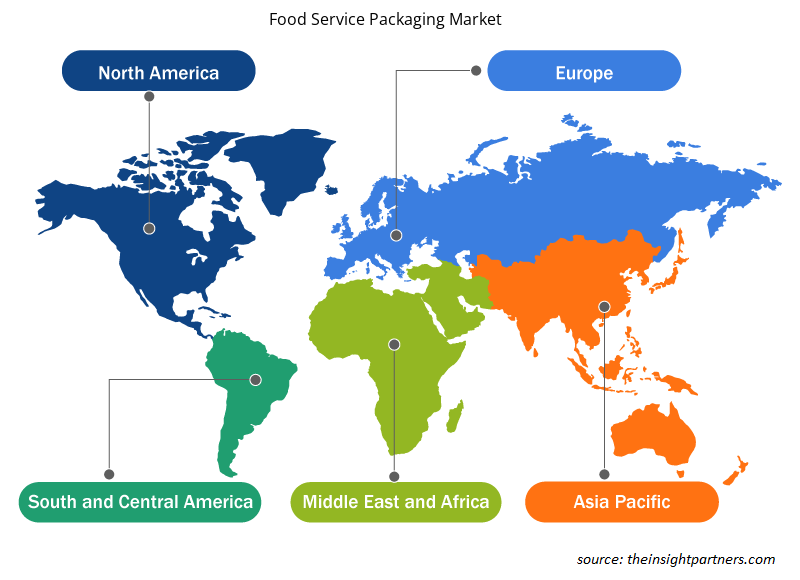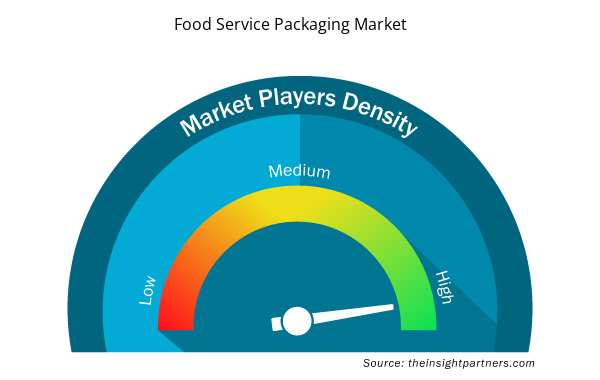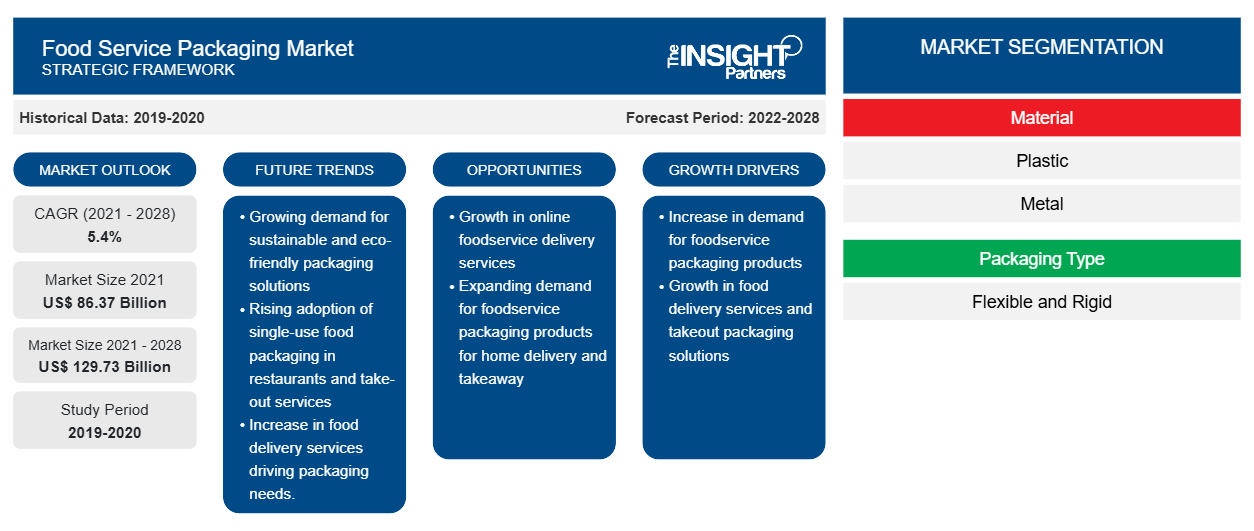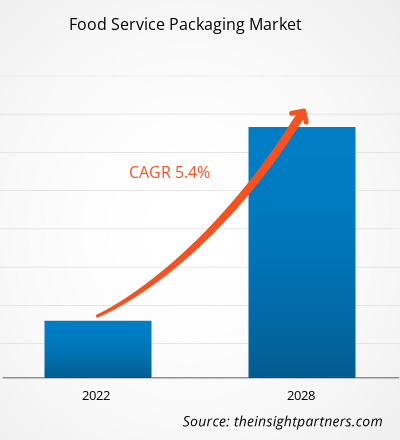[調査レポート] 食品サービス用包装市場は2021年に863億7,208万米ドルと評価され、2028年には1297億2,893万米ドルに達すると予測されており、2021年から2028年にかけて5.4%のCAGRで成長すると予想されています。
食品サービス用パッケージには、店内飲食、持ち帰り食品サービス施設、宅配で調理済み食品や飲料の提供やパッケージに使用される製品が含まれます。食品サービス用パッケージ製品には、ホット飲料とコールド飲料のカップ、皿、トレイ、ボウル、バッグ (シングルサービスと持ち帰り用)、容器と蓋、カトラリーと食器、アイスクリームカップ、スープカップ、飲料キャリアが含まれます。これらの製品は、微生物、空気、湿気による汚染から食品を保護します。
2020年、アジア太平洋地域は世界の食品サービス用包装市場で最大の収益シェアを占めました。アジア太平洋地域の食品サービス用包装市場を牽引しているのは、主にフルサービスレストランやカフェなどからの食品サービス用包装製品への高い需要です。この地域では、これらのプラットフォームが提供する利便性により、オンラインでの食品注文が増加しており、さまざまな食品サービス用包装製品への大きな需要も生まれています。中国とインドは、アジア太平洋地域の市場における主要国です。インドでは、都市部の住民の間で外食の傾向が高まっており、それが同国の市場成長を後押ししています。
要件に合わせてレポートをカスタマイズする
このレポートの一部、国レベルの分析、Excelデータパックなど、あらゆるレポートを無料でカスタマイズできます。また、スタートアップや大学向けのお得なオファーや割引もご利用いただけます。
- このレポートの主要な市場動向を入手してください。この無料サンプルには、市場動向から見積もりや予測に至るまでのデータ分析が含まれます。
COVID-19パンデミックが食品サービス包装市場に与える影響
COVID-19パンデミックは、ロックダウン、渡航禁止、事業停止により、さまざまな国の経済や産業に影響を及ぼしました。2020年には、国境や国境の閉鎖によるバリューチェーンの混乱により、さまざまな産業が事業の減速を余儀なくされました。パンデミックは、さまざまな国の政府当局が課した制限により、製造プロセスを混乱させました。COVID-19の急速な拡大は、食品サービス業界に前例のない課題をもたらしました。世界中のさまざまな国で社会的距離政策によりレストラン、バー、クラブが閉鎖されたため、食品サービス用包装製品の需要に悪影響を及ぼしました。
しかし、テイクアウトやオンラインでの食品注文の増加により、レストランにチャンスが生まれています。経済は2021年に事業の復活を開始しました。レストラン、バー、クラブ、その他の食品サービス店のオープンにより、さまざまな食品サービス用パッケージ製品の需要がさらに高まっています。
市場洞察
包装製品の生産能力の拡大
保存期間が長く、品質が管理された新鮮な食品を消費したいという消費者の関心が高まり、食品包装製品の需要が生まれています。この要因により、食品包装メーカーは新しい安全な包装を設計、開発できます。さらに、人口増加により、食品生産部門は食品廃棄を減らすために強化された食品包装ソリューションを採用するようさらに圧力を受けています。したがって、食品業界を改善するための現在のアプローチは、食品包装の斬新で革新的な技術の開発に重要な投資を行うことで、食品の損傷と廃棄を減らすことを目指しています。
マテリアルインサイト
素材に基づいて、世界の食品サービス用包装市場は、プラスチック、金属、その他に分類されています。プラスチックセグメントは、2020年に世界の食品サービス用包装市場で最大のシェアを占めました。プラスチック包装は柔軟な包装形式です。これにより、食品サービスプロバイダーは、顧客の要件に応じて包装の形状、スタイル、サイズをカスタマイズできます。プラスチック包装は軽量であるため、食品サービス業界で好まれています。プラスチック包装のこれらの利点は、食品サービス業界の顧客を引き付けています。したがって、プラスチック食品サービス用包装の市場は急増しています。
アプリケーションインサイト
用途に基づいて、世界市場は飲料、調理済み食品、果物と野菜、パンと菓子、乳製品、その他に分類されています。
。
調理済み食事セグメントは、2020年に世界の食品サービス包装市場で最大のシェアを占めました。調理済み食事の包装には、バイオベースおよび生分解性のプラスチックとアルミニウムが使用されています。トレイシーリング、熱成形、スタンドアップパウチ、レトルト包装およびパウチ、自己発熱缶、ストレッチフィルムが使用され、食品のパッケージプレゼンテーションをカスタマイズするのに役立ちます。
Graphic Packaging International, LLC、Amcor PLC、Cambay Technopack Private Limited、Huhtamaki Global、AR Packaging、WestRock Company、Genpak, LLC、Vegware Ltd、BeGreen Packaging、および Stora Enso は、世界の食品サービス用パッケージ市場で活動している主要企業です。世界の食品サービス用パッケージ市場で活動している企業は、研究開発活動への投資、新製品の発売、合併や買収などの戦略に常に注力しています。市場プレーヤーは、顧客の需要を満たすために高品質の製品を提供することに重点を置いています。
レポートの注目点
- 食品サービス包装市場における進歩的な業界動向は、プレーヤーが効果的な長期戦略を策定するのに役立ちます。
- 先進国市場と発展途上国市場で採用されているビジネス成長戦略
- 2019年から2028年までの食品サービス包装市場の定量分析
- 食品サービス用包装の世界需要の推定
- 業界で活動するバイヤーとサプライヤーの有効性を示すポーターの5つの力の分析
- 競争市場の状況を理解するための最近の動向
- 食品サービス包装市場の成長を牽引・抑制する要因と市場動向および展望
- 商業的利益の基盤となる市場戦略を強調し、市場の成長につながる意思決定プロセスを支援する
- 食品サービス包装市場の規模
- 市場の詳細な概要とセグメンテーション、および食品サービス包装業界の動向
- 有望な成長機会があるさまざまな地域の食品サービス用包装市場の規模
食品サービス用パッケージ市場の地域別洞察
予測期間を通じて食品サービス用パッケージング市場に影響を与える地域的な傾向と要因は、Insight Partners のアナリストによって徹底的に説明されています。このセクションでは、北米、ヨーロッパ、アジア太平洋、中東、アフリカ、南米、中米にわたる食品サービス用パッケージング市場のセグメントと地理についても説明します。

- 食品サービス包装市場の地域別データを入手
食品サービスパッケージ市場レポートの範囲
| レポート属性 | 詳細 |
|---|---|
| 2021年の市場規模 | 863.7億米ドル |
| 2028年までの市場規模 | 1,297.3億米ドル |
| 世界のCAGR(2021年~2028年) | 5.4% |
| 履歴データ | 2019-2020 |
| 予測期間 | 2022-2028 |
| 対象セグメント | 素材別
|
| 対象地域と国 | 北米
|
| 市場リーダーと主要企業プロフィール |
|
食品サービスパッケージ市場のプレーヤー密度:ビジネスダイナミクスへの影響を理解する
食品サービス用パッケージ市場は、消費者の嗜好の変化、技術の進歩、製品の利点に対する認識の高まりなどの要因により、エンドユーザーの需要が高まり、急速に成長しています。需要が高まるにつれて、企業は提供品を拡大し、消費者のニーズを満たすために革新し、新たなトレンドを活用し、市場の成長をさらに促進しています。
市場プレーヤー密度とは、特定の市場または業界内で活動している企業または会社の分布を指します。これは、特定の市場スペースに、その規模または総市場価値と比較して、どれだけの競合相手 (市場プレーヤー) が存在するかを示します。
食品サービス用包装市場で事業を展開している主要企業は次のとおりです。
- グラフィックパッケージングホールディングカンパニー
- アムコール
- フタマキ
- ウェストロック社
- ジェンパック LLC
免責事項:上記の企業は、特定の順序でランク付けされていません。

- 食品サービスパッケージ市場のトップキープレーヤーの概要を入手
世界の食品サービス包装市場
材料
- プラスチック
- 金属
- その他
梱包タイプ
- フレキシブル
- 硬い
応用
- 飲料
- 調理済み食事
- 果物と野菜
- パン・菓子
- 乳製品
- その他
企業プロフィール
- グラフィック パッケージング インターナショナル LLC
- アムコールPLC
- カンベイテクノパックプライベートリミテッド
- フフタマキグローバル
- ARパッケージ
- ウェストロック社
- ジェンパック LLC
- ベジウェア株式会社
- BeGreenパッケージ
- ストーラ エンソ
- 過去2年間の分析、基準年、CAGRによる予測(7年間)
- PEST分析とSWOT分析
- 市場規模価値/数量 - 世界、地域、国
- 業界と競争環境
- Excel データセット



Report Coverage
Revenue forecast, Company Analysis, Industry landscape, Growth factors, and Trends

Segment Covered
This text is related
to segments covered.

Regional Scope
North America, Europe, Asia Pacific, Middle East & Africa, South & Central America

Country Scope
This text is related
to country scope.
よくある質問
The global food service packaging market is highly competitive owing to the presence of several regional and global players. Players compete with each other based on product quality and prices.
In 2021, Asia Pacific held the largest share of the global food service packaging market. The food service packaging market in Asia Pacific is driven by rise in number of food chains in the region, rise in disposable income of individuals, a growing preference towards fast food services, etc. factors.
Some of the major players operating in the global food service packaging market include Graphic Packaging Holding Company; Amcor plc ; Huhtamaki; WestRock Company; Genpak, LLC; BeGreen Packaging; Stora Enso; Berry Global Inc.; Sealed Air; and Ball Corporation.
Asia Pacific is estimated to register the fastest CAGR in the global food service packaging market over the forecast period. Rapid infrastructure growth, including new airports and expressways in the region, has given scope to various food chains to set up their outlets, creating demand for the food service packaging in the region.
The plastic segment held the largest share of the global food service packaging market in 2021. Plastic packaging is preferred in the foodservice industry as it is light-weight. Furthermore, the plastic packaging products used in food packaging are easy to transport.
The global food service packaging market is primarily driven by proliferation in production capacity of packaging products and changing customer preferences for high-quality and standard products.
Trends and growth analysis reports related to Chemicals and Materials : READ MORE..
The List of Companies - Food Service Packaging Market
- Graphic Packaging Holding Company
- Amcor plc
- Huhtamaki
- WestRock Company
- Genpak, LLC
- BeGreen Packaging
- Stora Enso
- Berry Global Inc.
- Sealed Air
- Ball Corporation
The Insight Partners performs research in 4 major stages: Data Collection & Secondary Research, Primary Research, Data Analysis and Data Triangulation & Final Review.
- Data Collection and Secondary Research:
As a market research and consulting firm operating from a decade, we have published and advised several client across the globe. First step for any study will start with an assessment of currently available data and insights from existing reports. Further, historical and current market information is collected from Investor Presentations, Annual Reports, SEC Filings, etc., and other information related to company’s performance and market positioning are gathered from Paid Databases (Factiva, Hoovers, and Reuters) and various other publications available in public domain.
Several associations trade associates, technical forums, institutes, societies and organization are accessed to gain technical as well as market related insights through their publications such as research papers, blogs and press releases related to the studies are referred to get cues about the market. Further, white papers, journals, magazines, and other news articles published in last 3 years are scrutinized and analyzed to understand the current market trends.
- Primary Research:
The primarily interview analysis comprise of data obtained from industry participants interview and answers to survey questions gathered by in-house primary team.
For primary research, interviews are conducted with industry experts/CEOs/Marketing Managers/VPs/Subject Matter Experts from both demand and supply side to get a 360-degree view of the market. The primary team conducts several interviews based on the complexity of the markets to understand the various market trends and dynamics which makes research more credible and precise.
A typical research interview fulfils the following functions:
- Provides first-hand information on the market size, market trends, growth trends, competitive landscape, and outlook
- Validates and strengthens in-house secondary research findings
- Develops the analysis team’s expertise and market understanding
Primary research involves email interactions and telephone interviews for each market, category, segment, and sub-segment across geographies. The participants who typically take part in such a process include, but are not limited to:
- Industry participants: VPs, business development managers, market intelligence managers and national sales managers
- Outside experts: Valuation experts, research analysts and key opinion leaders specializing in the electronics and semiconductor industry.
Below is the breakup of our primary respondents by company, designation, and region:

Once we receive the confirmation from primary research sources or primary respondents, we finalize the base year market estimation and forecast the data as per the macroeconomic and microeconomic factors assessed during data collection.
- Data Analysis:
Once data is validated through both secondary as well as primary respondents, we finalize the market estimations by hypothesis formulation and factor analysis at regional and country level.
- Macro-Economic Factor Analysis:
We analyse macroeconomic indicators such the gross domestic product (GDP), increase in the demand for goods and services across industries, technological advancement, regional economic growth, governmental policies, the influence of COVID-19, PEST analysis, and other aspects. This analysis aids in setting benchmarks for various nations/regions and approximating market splits. Additionally, the general trend of the aforementioned components aid in determining the market's development possibilities.
- Country Level Data:
Various factors that are especially aligned to the country are taken into account to determine the market size for a certain area and country, including the presence of vendors, such as headquarters and offices, the country's GDP, demand patterns, and industry growth. To comprehend the market dynamics for the nation, a number of growth variables, inhibitors, application areas, and current market trends are researched. The aforementioned elements aid in determining the country's overall market's growth potential.
- Company Profile:
The “Table of Contents” is formulated by listing and analyzing more than 25 - 30 companies operating in the market ecosystem across geographies. However, we profile only 10 companies as a standard practice in our syndicate reports. These 10 companies comprise leading, emerging, and regional players. Nonetheless, our analysis is not restricted to the 10 listed companies, we also analyze other companies present in the market to develop a holistic view and understand the prevailing trends. The “Company Profiles” section in the report covers key facts, business description, products & services, financial information, SWOT analysis, and key developments. The financial information presented is extracted from the annual reports and official documents of the publicly listed companies. Upon collecting the information for the sections of respective companies, we verify them via various primary sources and then compile the data in respective company profiles. The company level information helps us in deriving the base number as well as in forecasting the market size.
- Developing Base Number:
Aggregation of sales statistics (2020-2022) and macro-economic factor, and other secondary and primary research insights are utilized to arrive at base number and related market shares for 2022. The data gaps are identified in this step and relevant market data is analyzed, collected from paid primary interviews or databases. On finalizing the base year market size, forecasts are developed on the basis of macro-economic, industry and market growth factors and company level analysis.
- Data Triangulation and Final Review:
The market findings and base year market size calculations are validated from supply as well as demand side. Demand side validations are based on macro-economic factor analysis and benchmarks for respective regions and countries. In case of supply side validations, revenues of major companies are estimated (in case not available) based on industry benchmark, approximate number of employees, product portfolio, and primary interviews revenues are gathered. Further revenue from target product/service segment is assessed to avoid overshooting of market statistics. In case of heavy deviations between supply and demand side values, all thes steps are repeated to achieve synchronization.
We follow an iterative model, wherein we share our research findings with Subject Matter Experts (SME’s) and Key Opinion Leaders (KOLs) until consensus view of the market is not formulated – this model negates any drastic deviation in the opinions of experts. Only validated and universally acceptable research findings are quoted in our reports.
We have important check points that we use to validate our research findings – which we call – data triangulation, where we validate the information, we generate from secondary sources with primary interviews and then we re-validate with our internal data bases and Subject matter experts. This comprehensive model enables us to deliver high quality, reliable data in shortest possible time.


 このレポートの無料サンプルを入手する
このレポートの無料サンプルを入手する